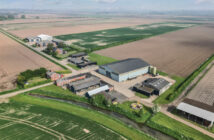Oilseed rape crops across the UK are mixed this year. There are some big, forward crops, however, in certain areas of the country the high levels of cabbage stem flea beetles (csfb) in the autumn have, as BASF Agronomy Managers feared, led to serious problems with csfb larvae.
Crops in the south have been especially badly hit. Andrew Clune said, “A small % of crops were lost to adult damage in the autumn but the bigger threat that we have at the moment is the huge amounts of larvae, into double figures per plant. The larvae are moving into the stems now and where the stem is elongating you can find them in the top third of the plant. It’s not pretty. There have been a few people who have tried topping and grazing the crop, to see what level of control they might be able to get in order to have some knowledge for future years .
We are assessing some crops on a daily basis to inform management decisions. However, on a more positive note, for growers who decide their crop is viable, we do know oilseed rape compensates well.”
Across in Norfolk, prospects are brighter, Hugo Pryce said, “Oilseed rape crops in and around Norfolk are at a range of differing growth stages largely determined by drilling date and variety, with the most forward crops approaching yellow bud but there are no major concerns at the moment.”
In contrast, next door in Suffolk, Matthew Keane reports that oilseed rape crops are mixed, He said, “Some crops look good, they are growing nicely, they’ve taken the early nitrogen and Caryx (metconazole and mepiquat chloride) is being applied if the green area index (GAI) was above 0.8 just prior to stem extension.Nearly all crops were above this threshold and, even those that have been damaged by csfb larvae are are starting to grow away well. It is still worth putting Caryx on these plants to help the branching and rooting, Caryx can be applied , from the start of stem extension through to yellow bud. If you have csfb damage then all you can do is help the plant to get to harvest.”
Over in the west, the majority of crops were not affected by csfb or their larvae, however Robin Rose is closely monitoring pollen beetle numbers. He said, “We have quite a few pollen beetles in crops but I think because we are so close to flowering that it isn’t going to be an issue. Once there are a few yellow flowers open the pollen beetles will migrate to those because they can access the pollen so much easier. At that point they become beneficial as they are pollinating the crop.”
Rory Galloway said, “In Yorkshire the crops are relatively forward, at green bud and motoring on so we are going to need good lodging control. Now is the perfect time to put Caryx on.”
Dr Charlotte White, ADAS Crop Physiology Research scientist, said, “Growers are becoming more aware of how lodging can impact on yield but there should be a no tolerance approach to lodging. ADAS found in lodging experiments that even leaning to a small degree (22.5 degrees) at seed fill can have a significant impact on yield compared to no lodging. This is probably due to shading reducing the amount of photosynthesis. ”
Lodging is driven by the size of the canopy, if the canopy is too large it is much more likely to lodge.
Dr White said, “To maximise yield growers need to manage their canopy from the beginning so when they are planting, aiming for 30-40 plants /m2. The rest of the canopy management is all about nitrogen timing and plant growth regulator (PGR) applications. Applying PGRs manipulates the canopy, decreasing crop height and changing the dominance from the primary stem through to the secondary stems, so encouraging secondary branching and giving the canopy a better shape for light interception.
A GAI of 3.5 at flowering gives the best ratio for light interception as you don’t have bare ground and all the light will be hitting something green but equally importantly the canopy isn’t too large so that you are not “wasting” any light from reflection.”




